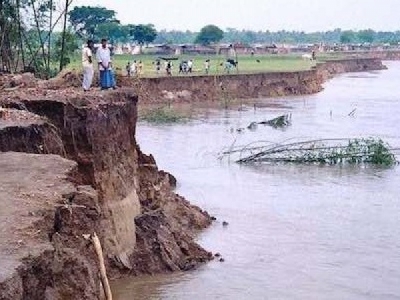
Posted on October 1, 2018
We are very shocked with the sudden Padma River’s bank erosion which is causing huge loss to the river side people of Naria and other areas. These huge loss of land-properties could be protected in large scale if the Govt. would have given attention to our low-cost dredging i.e. Bandalling with bamboo-chatai-trees, etc. Govt. of Bangladesh is spending huge amount of hard-earned money to control flood, riverbank erosion.
A joint study by Prof. Md. Mansur Rahman and Prof. Anisur Rahman of BUET in collaboration with Prof. Hajime Nakagawa and Prof. Taisuke Ishigaki of Disaster prevention Research Institute of Kyoto University, Japan with the assistance of River Research Institute, Faridpur in 2004-05 found that dredging is very expensive (about 10 times) as compared with the Bandals in order to maintain navigational channels.
The conclusion was – Bandals are much cheaper method as compared with dredging option to provide required flow depth for safe navigation. Dredging in alluvial rivers like Jamuna-Surma-Kushiyara-Padma/Ganges are not sustainable even for one season. Towards the development of sustainable solution to maintain the navigability, BANDALs or combination of Bandals and dredging may provide the desired solution. Channel depth could be increased to 8 to 10 ft by Bandalling.
In the alluvial rivers with erodable boundaries the bank erosion is drastic and channel width increases in an order of several hundred meters per year. As a result the major rivers in Bangladesh are shifting their courses every year creating acute problems at the local and national levels.
To minimize these sufferings based on the working principles of BANDALs, an idea is developed so that it can be used to stabilize rivers’ courses for long-term basis in a step-by-step manner. River flow is suddenly disturbed by Spur-dyke-Like structures (Rahman & Muramoto, 1999) and consequently their responses are big against such interventions. Therefore watercourses cannot be stabilized for long-term basis.
The gradual encroachment towards the lateral directions using BANDALs creates less disturbance to the rivers and the rivers can get sufficient time for it’s adjustment and new bank line development. The study concluded – BANDALs have positive impact for the increase of navigational flow depth in alluvial rivers.
The out put of the research for the stabilization of river courses can solve the problems of Bangladesh that is more or less inherent due to the complex geographical location at the lower riparian of the catchment. From experimental and theoretical analyses, it is found that BANDALs are capable for flow diversion towards the main channel leading to deep navigational channel formation.
On the other hand flow velocities are reduced near the riverbank lines that ensure bank protection. In addition to this, the local scours around these structures are much less than it is the case of impermeable Groins. Therefore Bandals would be less expensive solution over conventional methods. Another important feature of Bandal is that the lateral interventions can be extended gradually that can be possible using conventional structures, such as Groins, Revetments.
The Authority is doing penny wise – pound folish decision about the very conventional Low-cost natural dredging i.e. Bandalling systems for their ignorance and unholistic consideration for improvement of navigational channels in Jamuna/Brahmaputra, Ganges/Padma, Upper Meghna, Surma and Kushiayra alluvial rivers. Where BUET IWFM, IWM of BWDB, RRI, experts of Japan, India and the old experienced Officers of CPD, BIWTA are in the same opinion that to save money and to control flood, river bank erosion and to increase depth of main channels BANDALLING is very essential in the beginning of November every year till 31st March.
The Ministry of Shipping, BIWTA and BWDB should reconsider the Low-cost Natural Dredging i.e. Bandalling with Bamboo, Bamboo-made mats, jute ropes, wood, small trees, etc which is very effective for a developing nation.
Source: New Nation





